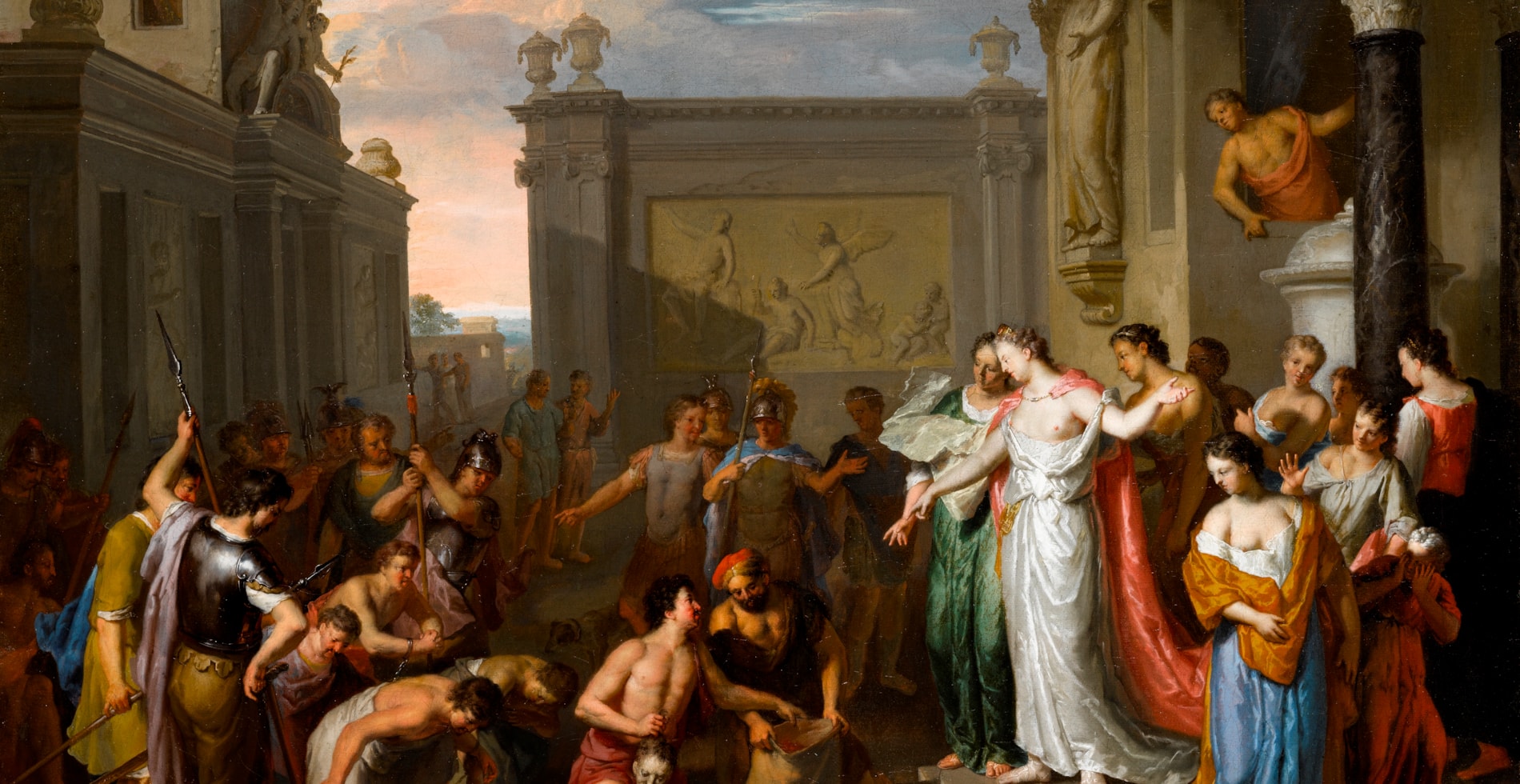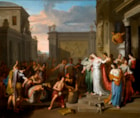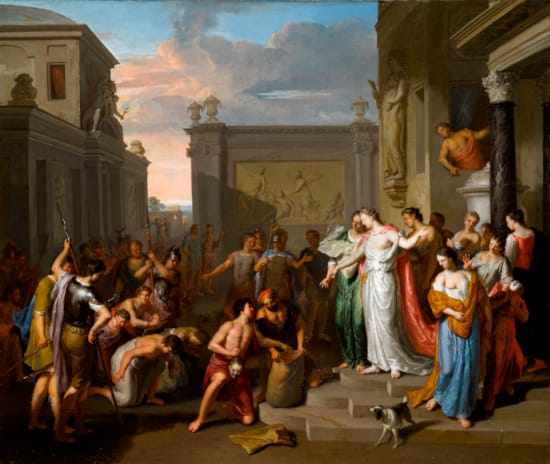erard Hoet
(Zaltbommel 1648 - The Hague 1733)
The Head of Cyrus being Presented to Queen Tomyris
signed ‘G. Hoet.’ (lower right)
oil on canvas
54 x 64 cm (12¼ x 25¼ in)
This work depicts the Tomyris, Queen of the Massagetai, taking her famous vengeance against the Persian emperor Cyrus the Great. As recorded by Herodotus, Cyrus invaded Tomyris’ kingdom and when challenged to battle laid a trap: the Persians left behind them a seemingly abandoned camp, in which there was a pre-prepared banquet. Led by Tomyris’ son Spargapises, the Massagetai found the camp, where they indulged in the feast and unused to alcohol, soon fell asleep. The Persians returned and either slaughtered or captured a great many of the Massagetai. Among the captives was Spargapises, who committed suicide because of the calamity that had taken place under his command. Learning of this defeat, Tomyris sent a herald to Cyrus, giving him a final chance to leave her lands and telling him that as bloodthirsty as he was, if he refused she would give him his fill of blood. Unsurprisingly Cyrus ignored her warnings and so a second battle took place which the Massagetai won. The Queen demanded that the corpse of Cyrus be decapitated and the head be dipped in a sack of blood. As this took place she said ‘Though I am alive and have defeated you in battle, you have destroyed me, taking my son by guile; but just as I threatened, I give you your fill of blood’.¹
It is Tomyris’ memorable revenge that Gerard Hoet has chosen to depict. Cyrus’ severed head is placed centrally and, drained of all colour, it is about to be plunged into the sack of blood on Tomyris’ command. A few of the courtiers are too shocked to look but the majority remain calm and grimfaced. The Persian prisoners remain kneeling, clearly terrified that a similar fate awaits them.
The present work is comparable to many of Hoet’s historical paintings, in particular the Rijskmuseum’s Queen Cleophis Submits to Alexander after the Fall of Mazaka by Offering him a Cup of Wine. The two works are both set in similar palace courtyards, beyond which are an Italianate sky and landscape, which reflects the influence of Hoet’s teacher Cornelis van Poelenburgh (1594-1667). In each case the figures are arranged in a relatively theatrical, frieze-like composition, with a marked contrast between the male figures on the left-hand side, with the women to the right. In fact the figures of Tomyris and Cleophis could well derive from the same model. Despite their compositional similarities, the treatment of The Head of Cyrus being Presented to Queen Tomyris is much more refined than the Rijsmuseum’s work, and has the finesse associated with Hoet’s best work.
The subject of the present work was only revealed after recent careful restoration. At some point, probably during the nineteenth century, Cyrus’ head was overpainted so that it became a jug, and the blood in the sack turned into more treasure. Thus the scene came to depict prisoners offering gold to their captor, and the true subject remained elusive. Now that the painting has returned to its original state, the subject can be identified, and with it provenance tracing back to the turn of the nineteenth century. The description and measurements listed in the catalogue of the 1804 sale perfectly correlate with the present work.²
Hoet trained under his father, the glass painter Mozez Hoet, and later under Warnard van Ryzen (1625-1670) and van Poelenburgh. In 1672, when the French took over Protestant Zaltbommel, he moved to The Hague. From there he moved to Paris and was planning on travelling to England, before being advised that there was more work in the French capital. He stayed in Paris for more than a year before returning to the northern Netherlands via Brussels. He settled in Utrecht, where in 1697 he founded a drawing academy, but in 1715 he became a member of the Guild of St. Luke in The Hague and it was in this city that he spent the rest of his life. His work was much sought after and fetched high prices during his lifetime.
¹ Herodotus, Histories, I:214.
² Fredericksen, B. B., & Peronnet, B., Répertore des Tableaux Vendus en France au XIXe Siècle (Getty Publications, 1998), vol. 1, pp. 531-532.
Louis Chrétien Lorch; his sale, Alexandre Joseph Paillet, Paris, 19 November 1804, lot 48, 275 frs;
to Pierre Joseph Lafontaine (1758-1835);
acquired by the previous German private collector in January 1962.
This work depicts the Tomyris, Queen of the Massagetai, taking her famous vengeance against the Persian emperor Cyrus the Great. As recorded by Herodotus, Cyrus invaded Tomyris’ kingdom and when challenged to battle laid a trap: the Persians left behind them a seemingly abandoned camp, in which there was a pre-prepared banquet. Led by Tomyris’ son Spargapises, the Massagetai found the camp, where they indulged in the feast and unused to alcohol, soon fell asleep. The Persians returned and either slaughtered or captured a great many of the Massagetai. Among the captives was Spargapises, who committed suicide because of the calamity that had taken place under his command. Learning of this defeat, Tomyris sent a herald to Cyrus, giving him a final chance to leave her lands and telling him that as bloodthirsty as he was, if he refused she would give him his fill of blood. Unsurprisingly Cyrus ignored her warnings and so a second battle took place which the Massagetai won. The Queen demanded that the corpse of Cyrus be decapitated and the head be dipped in a sack of blood. As this took place she said ‘Though I am alive and have defeated you in battle, you have destroyed me, taking my son by guile; but just as I threatened, I give you your fill of blood’.¹
It is Tomyris’ memorable revenge that Gerard Hoet has chosen to depict. Cyrus’ severed head is placed centrally and, drained of all colour, it is about to be plunged into the sack of blood on Tomyris’ command. A few of the courtiers are too shocked to look but the majority remain calm and grimfaced. The Persian prisoners remain kneeling, clearly terrified that a similar fate awaits them.
The present work is comparable to many of Hoet’s historical paintings, in particular the Rijskmuseum’s Queen Cleophis Submits to Alexander after the Fall of Mazaka by Offering him a Cup of Wine. The two works are both set in similar palace courtyards, beyond which are an Italianate sky and landscape, which reflects the influence of Hoet’s teacher Cornelis van Poelenburgh (1594-1667). In each case the figures are arranged in a relatively theatrical, frieze-like composition, with a marked contrast between the male figures on the left-hand side, with the women to the right. In fact the figures of Tomyris and Cleophis could well derive from the same model. Despite their compositional similarities, the treatment of The Head of Cyrus being Presented to Queen Tomyris is much more refined than the Rijsmuseum’s work, and has the finesse associated with Hoet’s best work.
The subject of the present work was only revealed after recent careful restoration. At some point, probably during the nineteenth century, Cyrus’ head was overpainted so that it became a jug, and the blood in the sack turned into more treasure. Thus the scene came to depict prisoners offering gold to their captor, and the true subject remained elusive. Now that the painting has returned to its original state, the subject can be identified, and with it provenance tracing back to the turn of the nineteenth century. The description and measurements listed in the catalogue of the 1804 sale perfectly correlate with the present work.²
Hoet trained under his father, the glass painter Mozez Hoet, and later under Warnard van Ryzen (1625-1670) and van Poelenburgh. In 1672, when the French took over Protestant Zaltbommel, he moved to The Hague. From there he moved to Paris and was planning on travelling to England, before being advised that there was more work in the French capital. He stayed in Paris for more than a year before returning to the northern Netherlands via Brussels. He settled in Utrecht, where in 1697 he founded a drawing academy, but in 1715 he became a member of the Guild of St. Luke in The Hague and it was in this city that he spent the rest of his life. His work was much sought after and fetched high prices during his lifetime.
¹ Herodotus, Histories, I:214.
² Fredericksen, B. B., & Peronnet, B., Répertore des Tableaux Vendus en France au XIXe Siècle (Getty Publications, 1998), vol. 1, pp. 531-532.
Louis Chrétien Lorch; his sale, Alexandre Joseph Paillet, Paris, 19 November 1804, lot 48, 275 frs;
to Pierre Joseph Lafontaine (1758-1835);
acquired by the previous German private collector in January 1962.





 contact
contact contact
contact +44 20 7313 8040
+44 20 7313 8040









